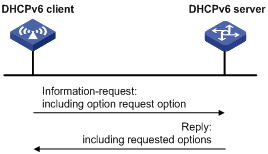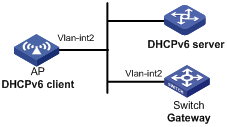- Table of Contents
- Related Documents
-
| Title | Size | Download |
|---|---|---|
| 07-DHCPv6 Configuration | 94.33 KB |
Table of Contents
Typical DHCPv6 Network Application
Stateless DHCPv6 Configuration
Displaying and Maintaining DHCPv6
Stateless DHCPv6 Client Configuration Example
l Support of the H3C WA series WLAN access points (APs) for features may vary by AP model. For more information, see Feature Matrix.
l The interface types and the number of interfaces vary by AP model.
l The term AP in this document refers to common APs, wireless bridges, and mesh APs.
l The models listed in this document are not applicable to all regions. Please consult your local sales office for the models applicable to your region.
![]()
Support for the DHCPv6 configuration depends on the AP model.
This chapter includes these sections:
l DHCPv6 Configuration Overview
l Configuring the DHCPv6 Client
l Displaying and Maintaining DHCPv6
l DHCPv6 Configuration Example
DHCPv6 Configuration Overview
The Dynamic Host Configuration Protocol for IPv6 (DHCPv6) was designed based on IPv6 addressing scheme and is used for assigning IPv6 addresses and other configuration parameters to hosts.
Compared with other IPv6 address allocation methods (such as manual configuration and stateless address autoconfiguration), DHCPv6 can:
l Record addresses assigned to hosts and assign addresses to specific hosts, thus facilitating network management.
l Assign configuration parameters to hosts, such as the DNS server address and domain name.
Basic Concepts
Multicast address of all DHCPv6 servers and relay agents
The multicast address FF02::1:2 identifies all DHCPv6 servers and relay agents on the local link.
DUID
A DHCP unique identifier (DUID) uniquely identifies a DHCPv6 device (DHCPv6 client, relay agent, or server), and is used for authentication between DHCPv6 devices.
Currently, a DUID based on link-layer address (DUID-LL) defined in RFC 3315 is used to identify a DHCPv6 device. The DUID-LL format is as shown in Figure 1-1, where:
l DUID type: The value 0x0003 indicates that the DUID type is DUID-LL.
l Hardware type: The device supports Ethernet as the hardware type with the value of 0x0001.
l Link layer address: Its value is the bridge MAC address of the device.

Typical DHCPv6 Network Application
Figure 1-2 Network diagram for DHCPv6

Figure 1-2 shows a typical DHCPv6 network. Each DHCPv6 client uses a multicast address to contact the DHCPv6 server on the local link to obtain an IPv6 address and other configuration parameters. If the DHCPv6 server resides on another subnet, the DHCPv6 client can contact the server via a DHCPv6 relay agent. Thus, you do not need to deploy a DHCPv6 server on each subnet.
![]()
Currently, the AP only supports the DHCPv6 client and relay agent. Serving as a DHCPv6 client, the AP only supports stateless DHCPv6 configuration instead of stateful DHCPv6 configuration, that is, the AP can only obtain other network configuration parameters instead of an IPv6 address from the DHCPv6 server.
Stateless DHCPv6 Configuration
After obtaining an IPv6 address through stateless address autoconfiguration, an AP can use stateless DHCPv6 to obtain other configuration parameters (such as the DNS server address or domain name) from a DHCPv6 server. Because the DHCPv6 server does not maintain the state information of the AP, this application is called stateless DHCPv6 configuration.
![]()
Stateless address autoconfiguration means that a node automatically generates an IPv6 address based on the information obtained through router/prefix discovery. For more information, see IPv6 Basics in the Layer 3 – IP Services Configuration Guide.
With an IPv6 address obtained through stateless address autoconfiguration, an AP automatically enables the stateless DHCPv6 function after it receives an RA message with the managed address configuration flag (“M” flag) set to 0 and with the other stateful configuration flag (“O” flag) set to 1.
Two types of messages are exchanged in the operation of stateless DHCPv6: the information request message sent by the client and the reply message sent by the server.
Figure 1-3 Operation of stateless DHCPv6

As shown in Figure 1-3, stateless DHCPv6 operates as follows:
1) The DHCPv6 client multicasts an information request message to the destination address FF02::1:2. The information request message contains the option request option, specifying configuration parameters that the client requests from the DHCPv6 server.
2) After receiving the information request message, the DHCPv6 server returns a reply message containing the requested configuration parameters to the client.
3) The client checks the reply message. If the obtained configuration parameters match those requested in the information request message, the client performs network configuration with the parameters. If multiple replies are received, the first received reply will be used.
Protocols and Standards
l RFC 3736: Stateless Dynamic Host Configuration Protocol (DHCP) Service for IPv6
l RFC 3315: Dynamic Host Configuration Protocol for IPv6 (DHCPv6)
l RFC 2462: IPv6 Stateless Address Autoconfiguration
Configuring the DHCPv6 Client
Configuration Prerequisites
To make the DHCPv6 client obtain network configuration parameters through stateless DHCPv6 configuration successfully, make sure that the DHCPv6 server is usable.
Configuration Procedure
Follow these steps to configure the DHCPv6 client:
|
Use the command… |
Remarks |
|
|
Enter system view |
system-view |
— |
|
Enable the IPv6 packet forwarding function |
ipv6 |
Required |
|
Enter interface view |
interface interface-type interface-number |
— |
|
Enable IPv6 stateless address autoconfiguration |
ipv6 address auto |
Required |
![]()
l For more information about the ipv6 address auto command, see IPv6 Basics in the Layer 3 – IP Services Command Reference.
l With an IPv6 address obtained through stateless address autoconfiguration, an AP automatically enables the stateless DHCPv6 function to obtain other configuration parameters upon receiving an RA message with the “M” flag set to 0 and with the “O” flag set to 1.
l An interface cannot serve as a stateless DHCPv6 client and DHCPv6 relay agent at the same time.
Displaying and Maintaining DHCPv6
|
To do… |
Use the command… |
Remarks |
|
Display DHCPv6 client information |
display ipv6 dhcp client [ interface interface-type interface-number ] |
Available in any view |
|
Display DHCPv6 client statistics |
display ipv6 dhcp client statistics [ interface interface-type interface-number ] |
Available in any view |
|
Display the DUID of the local AP |
display ipv6 dhcp duid |
Available in any view |
|
Clear DHCPv6 client statistics |
reset ipv6 dhcp client statistics [ interface interface-type interface-number ] |
Available in user view |
DHCPv6 Configuration Example
Stateless DHCPv6 Client Configuration Example
Network requirements
As shown in Figure 1-4, through stateless DHCPv6, AP obtains the DNS server address, domain name, and other information from the server.
Switch acts as the gateway to send RA messages periodically.
Figure 1-4 Stateless DHCPv6 configuration

Configuration procedure
1) Configure Switch
# Enable the IPv6 packet forwarding function.
<Switch> system-view
[Switch] ipv6
# Configure the IPv6 address of VLAN-interface 2.
[Switch] interface vlan-interface 2
[Switch-Vlan-interface2] ipv6 address 1::1 64
# Set the “O” flag in the RA messages to 1.
[Switch-Vlan-interface2] ipv6 nd autoconfig other-flag
# Enable Switch to send RA messages.
[Switch-Vlan-interface2] undo ipv6 nd ra halt
2) Configure AP
# Enable the IPv6 packet forwarding function.
<AP> system-view
[AP] ipv6
# Enable stateless IPv6 address autoconfiguration on VLAN-interface 2.
[AP] interface vlan-interface 2
[AP-Vlan-interface2] ipv6 address auto
With this command executed, if VLAN-interface 2 has no IP address configured, AP will automatically generate a link-local address, and send an RS message, requesting the gateway (Switch) to reply with an RA message immediately.
Verification
After receiving an RA message with the “M” flag set to 0 and with the “O” flag set to 1, AP automatically enables the stateless DHCPv6 function.
# You can use the display ipv6 dhcp client command to view the current client configuration information. If the client successfully obtains configuration information from the server, the following information will be displayed.
[AP-Vlan-interface2] display ipv6 dhcp client interface vlan-interface 2
Vlan-interface2 is in stateless DHCPv6 client mode
State is OPEN
Preferred Server:
Reachable via address : FE80::213:7FFF:FEF6:C818
DUID : 0003000100137ff6c818
DNS servers : 1:2:3::5
1:2:4::7
Domain names : abc.com
Sysname.com
# You can use the display ipv6 dhcp client statistics command to view the current client statistics.
[AP-Vlan-interface2] display ipv6 dhcp client statistics
Interface : Vlan-interface2
Packets Received : 1
Reply : 1
Advertise : 0
Reconfigure : 0
Invalid : 0
Packets Sent : 5
Solicit : 0
Request : 0
Confirm : 0
Renew : 0
Rebind : 0
Information-request : 5
Release : 0
Decline : 0

